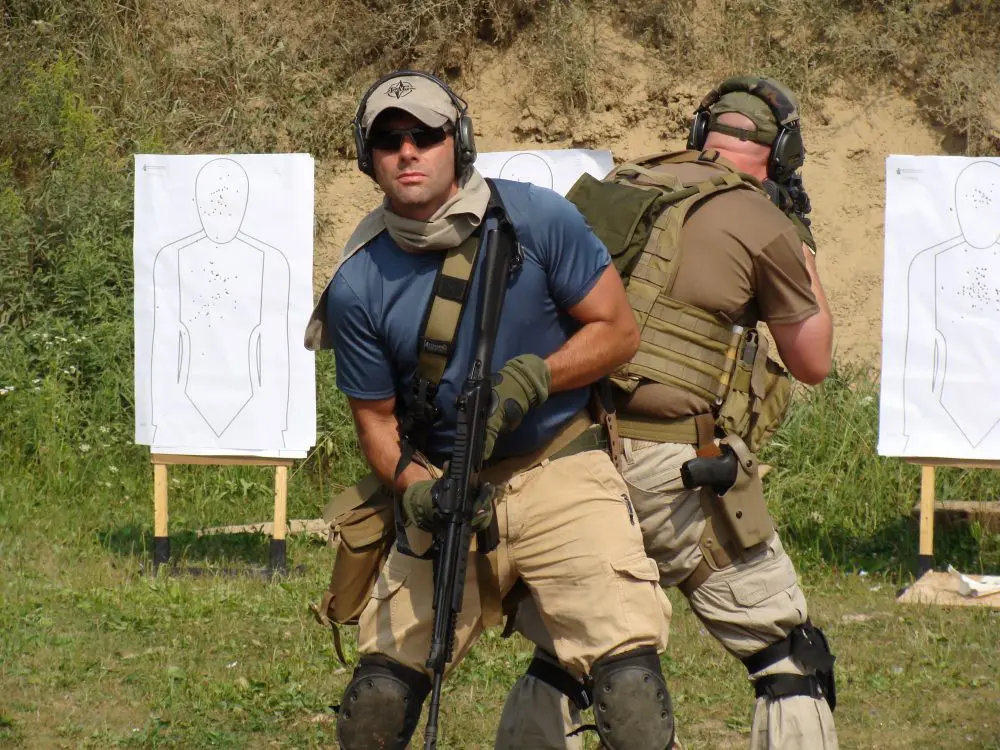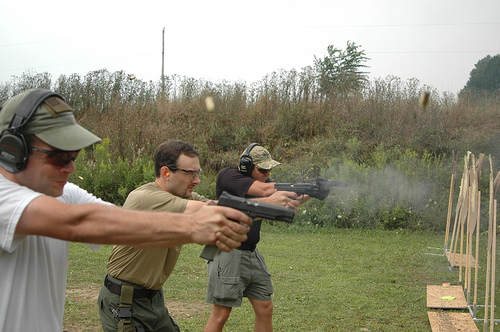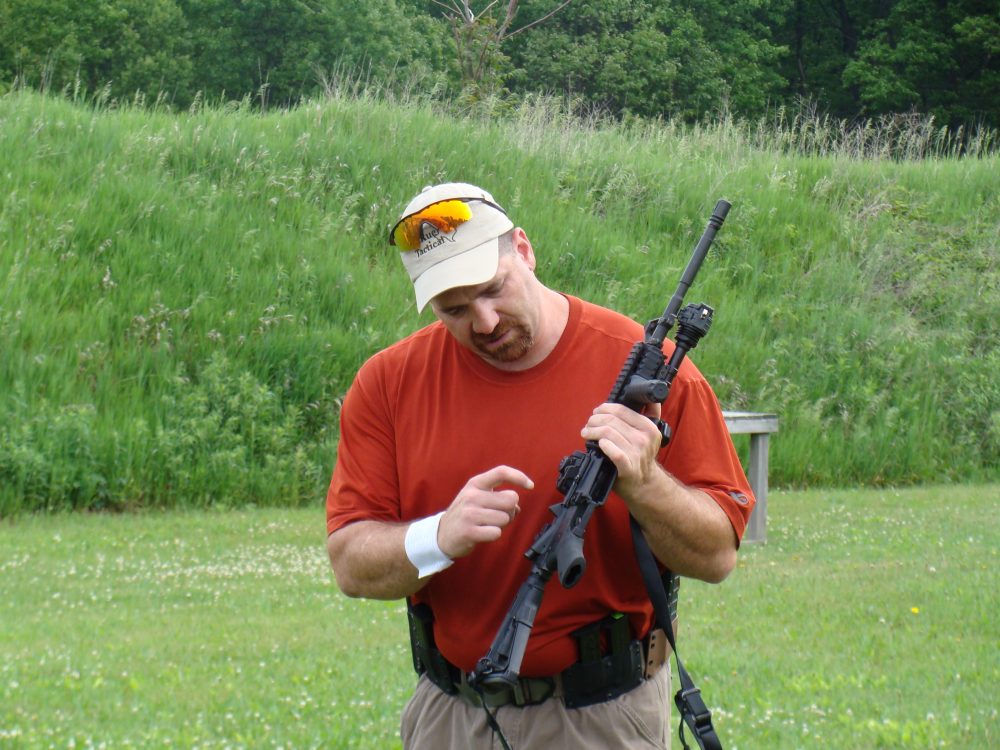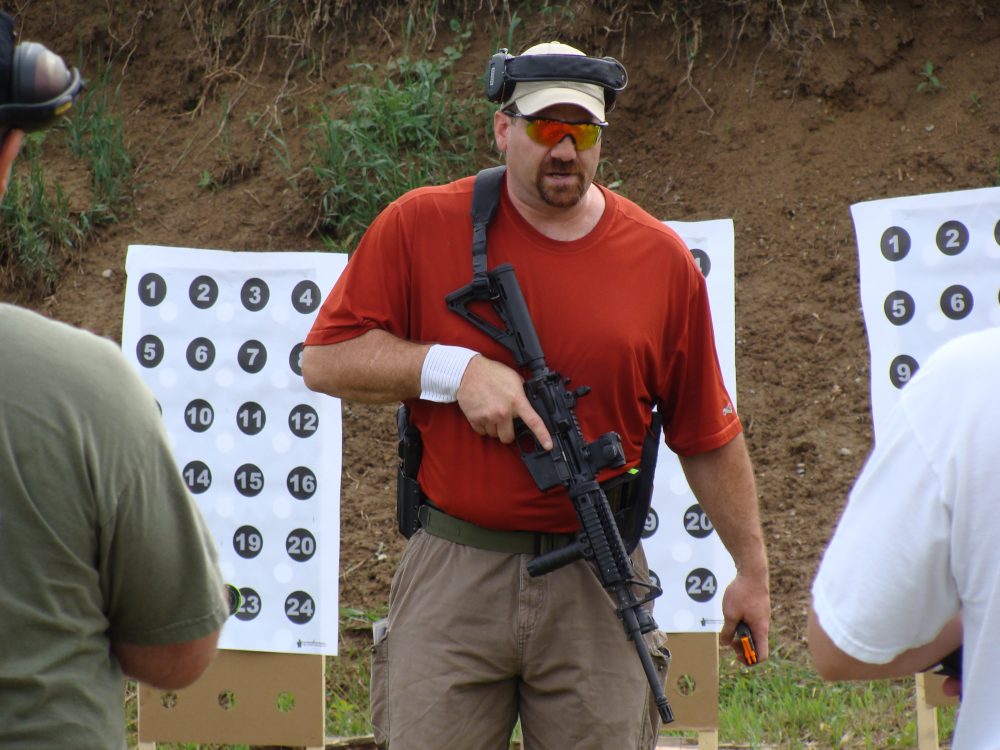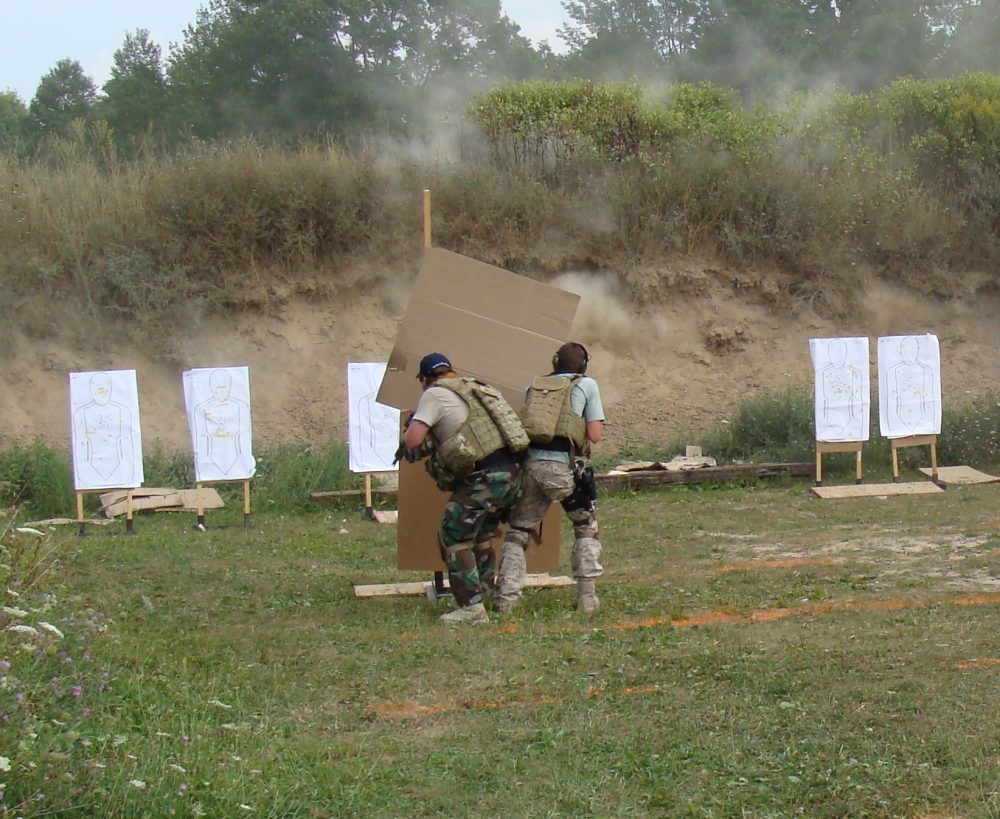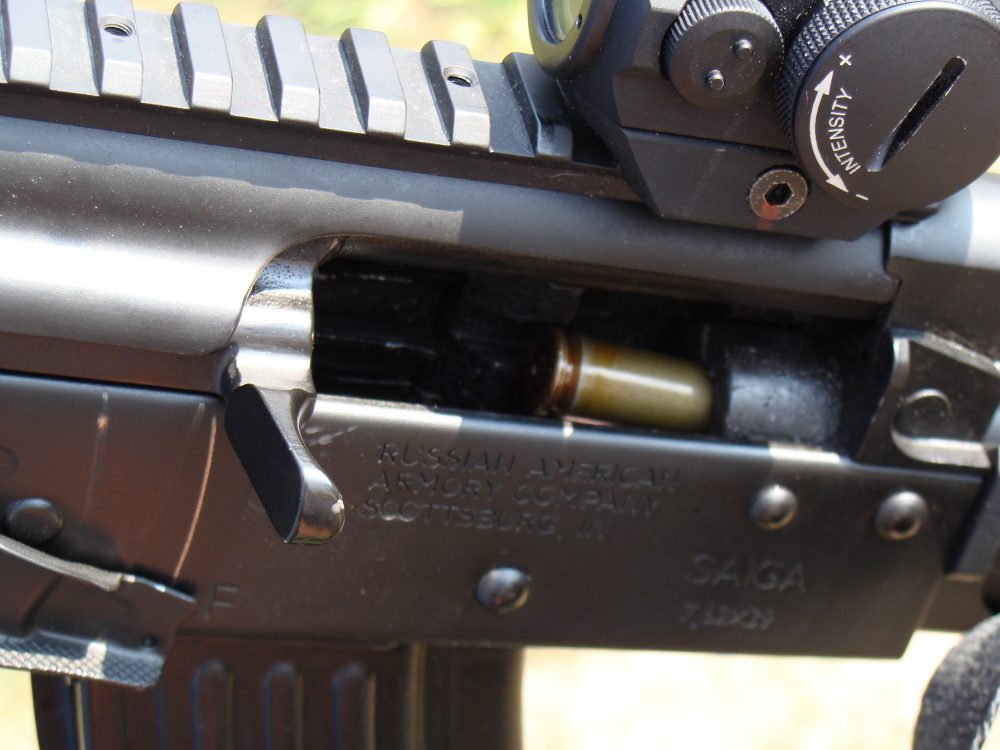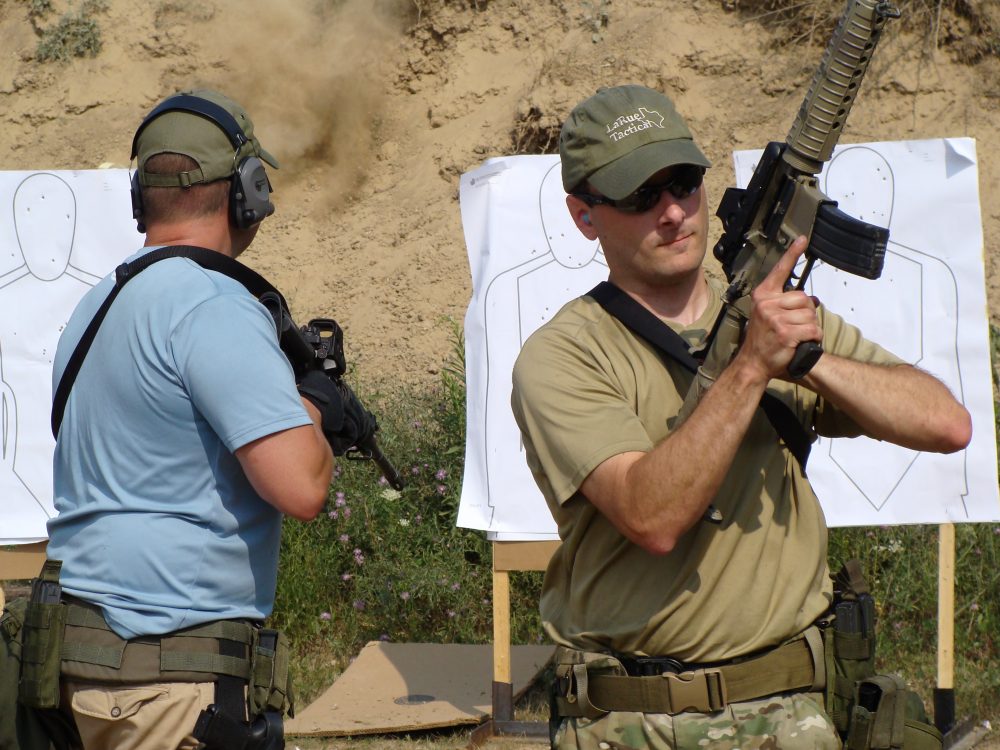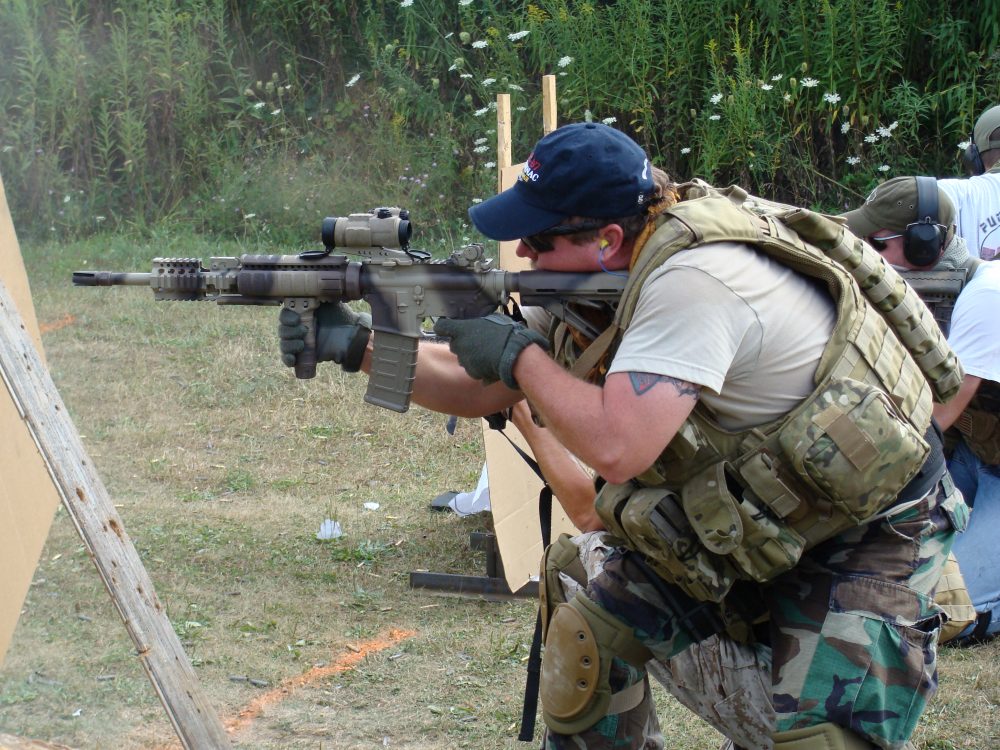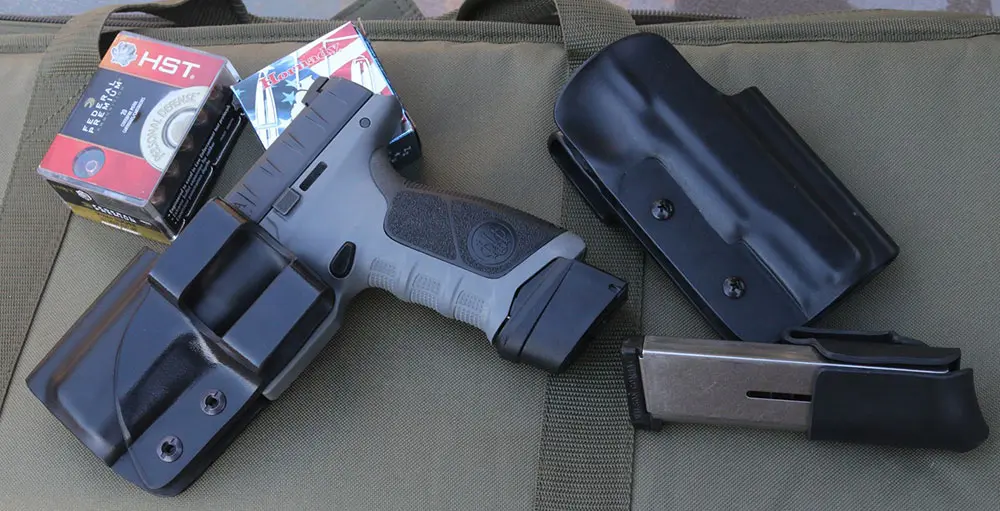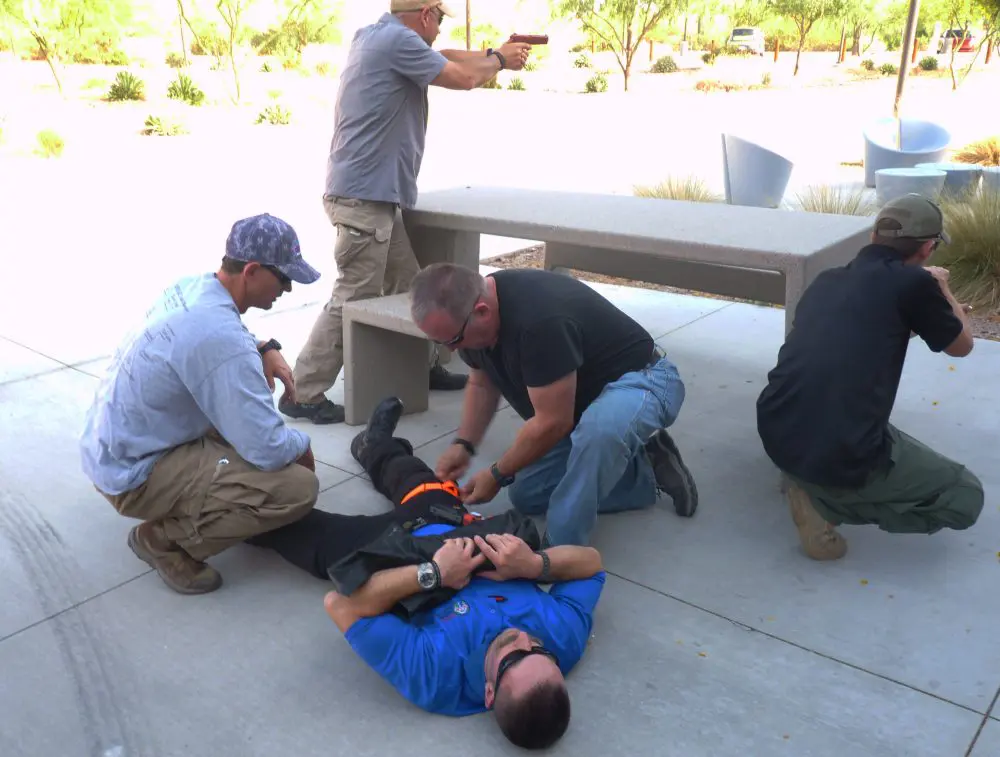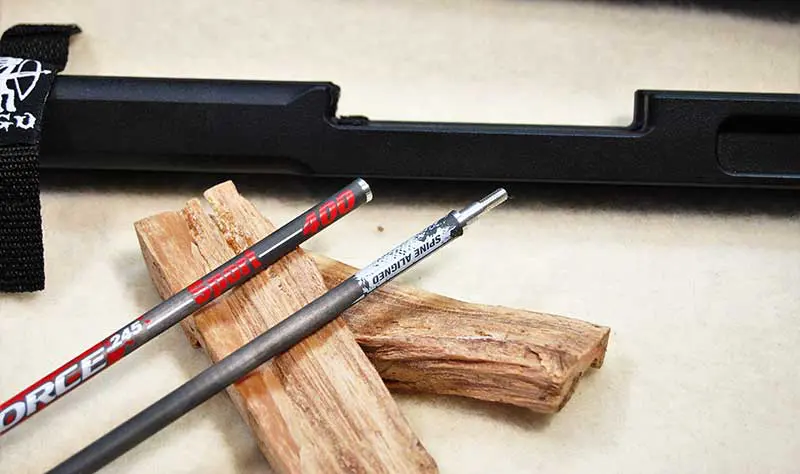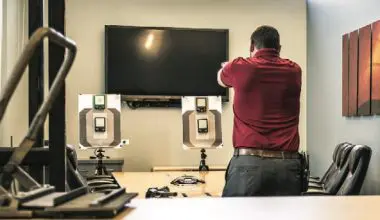I first met Steve Fisher at a firearms competition about three years ago. At the time, I was looking for advanced firearms training for competition and self-defense, and several people recommended Fisher’s company—Michigan Defensive Firearms Institute (MDFI). I witnessed his shooting ability first-hand at competitions and was amazed, to say the least.
Fisher is a tank, yet he moves incredibly fast for a man of his height and size. He is also especially adept at shooting on the move, maintaining better accuracy than many people I’ve seen shooting from a fixed position. However, for as talented as he is, everyone knows doing something well does not mean a person teaches it well.
Two-man team during Carbine 3 back-to-back and scanning 360 degrees.
Table of Contents
BLUE-RIBBON CREDS
One of the first indicators of Fisher’s teaching ability came to me from watching fellow competitors who attended his class. Month after month, there was a marked improvement in performance among competitors who trained with MDFI. It was also apparent that Fisher wasn’t keeping any secrets for himself, as students could fully explain why “this” worked better than “that,” while never professing any one way as “the” way. Speaking to MDFI students drew nothing but praise for Fisher’s approachability and direction.
In addition to private citizens, MDFI’s students have also included many veterans, law enforcement officers and currently enlisted servicemen. These individuals’ opinions are highly regarded due to their experience, and here again the reviews were positive. I also spoke with industry professionals from Raven Concealment, Trijicon, and other companies that train with MDFI to stay sharp for the sake of their customers. They spoke highly of MDFI and took what they learned back to work with them, helping to influence the products you see on the pages of this magazine. After all these positive testimonials, I decided it was time I experienced an MDFI class for myself.
Albaceli (middle) and two other students shoot on the move during MDFI Pistol 1.
PISTOL 1
My first class with MDFI is Pistol 1. We learn a little about Steve Fisher’s background as a former Deputy Sheriff Corrections Officer and about some of his philosophies regarding defensive shooting. His trainers over the past decade have included many instructors whom you have read about here in S.W.A.T. Magazine.
Fisher does not confine anyone to a particular stance, platform, or caliber—he’s there to teach you how to run yourself and your gear. He emphasizes that training is never over for anyone and encourages additional training, including from other instructors. Throughout the class students are encouraged to ask questions and to call a cease-fire any time they see anything unsafe.
Instructor Steve Fisher discusses AR malfunctions during Carbine 2.
Fisher employs a typical “walk before running” style, where students are first put through several different, simple drills at their own pace, building up to the end, where the drills are put together with a few extra surprises to keep you on your toes. If groups are very tight, the students are pushed to increase their speed. If groups are wild, they’re encouraged to slow down. Overall, accuracy sufficient for self-defense is stressed, and many different drills are presented to keep students thinking.
Pistol 1 has students executing simple movements, shooting while on the move and doing a lot of reloading. Heavy emphasis is put on scanning (looking for another bad guy), to break students from habits created while shooting at single targets on a static range.
Fisher introduces students to numbers drill during Carbine 2.
I recommend MDFI Pistol 1 to newcomers, shooters who have been away from training for a long time, and those interested in improving their self-defense shooting abilities. Pistol 1 provides an excellent platform on which to build from with additional training, whether it is with MDFI or another school. Concealed pistol license (CPL) holders should strongly consider Pistol 1, 2, and 3.
Competitors will benefit from these classes as well. However, it is important to note that these are defense classes, and that means race gear is not allowed—practical, CPL and duty-type gear only. If there is any question as to the appropriateness of a student’s equipment, they’re encouraged to contact MDFI in advance of any classes.
Carbine 3 students utilize oddly shaped concealment and try to adapt without exposing either person in the two-man team.
CARBINE 1, 2 and 3
I was pleased enough with Pistol 1 to take three more MDFI classes: Carbine 1, 2 and 3. As with Pistol 1, the lower-end Carbine classes are suitable for less experienced students, while the more advanced classes have been attended by LEO, competitive shooters and combat professionals from all over the world. Be prepared to work hard, because the advanced classes really put all your skills together and push the envelope. Students are required to think for themselves and truly fight through the drill, not just yank triggers.
Carbine 1 resembles the early pistol classes in the types of drills, but also incorporates new elements including transitioning from the carbine to the pistol. As before, students are pushed to think through their problems and instructed on how to run their gear better. As the classes advance, the students are pushed harder and faster, while previous drills are combined. By the end of Carbine 2, the drills are truly dynamic, challenging students to scan and engage targets from angles and positions that are meant to better prepare you for defensive situations.
Carbine 3 tests everyone’s skills and equipment. Even this AK isn’t exempt from problems. Know your malfunction drills well—any weapon can go down.
Carbine 3 has students paired up, working on two-man team skills. Everything learned from lower level pistol and carbine classes is built upon here. The class is less scripted as well. For example, should you clear a malfunction or go for your sidearm? The answer depends on the situation, and in advanced classes the answer will not come from the instructors, but from you, the shooter, so be prepared to explain “why” in case you are singled out. This isn’t done to be cruel—it’s a teaching tool. Everyone sees why a student did it his way, and the instructor shows you why that might not be the best answer for that given situation.
In Carbine 3, communication is key, because you’re paired up with a partner, and you’re both posed with challenges. You move in tandem, covering for each other and solving problems together. Hearing is extremely difficult during these drills, so a large part of the communication is by sight and touch. You have to let your partner know when you’re out of ammunition, when you’re ready to move and what areas you’re covering. My experience training in teams is limited, and this class proved to be very challenging, but my training partner and I never felt unsafe, and are planning on taking this class again in the near future.
Author reloads while his partner scans during Carbine 3.
SAFETY FIRST
Throughout all four classes, there were no problems with safety. I have been witness to unsafe actions by students and even instructors in other classes, and I’m happy to see someone finally get it right. Defense classes—especially advanced classes—are rigorous, tiring and complex. They are meant to push students to their limits, or else they aren’t doing them any good. Fisher maintains safety by constantly reminding students that they’re responsible for their actions, while also keeping a close eye on students for signs of fatigue. During breaks, Fisher strongly emphasizes the need to hydrate, rest and eat to keep energy up—even sharing his own provisions with his students on occasion.
MDFI classes strongly emphasize that firearms are tools, and that the real weapon is the gray matter between your ears. This is something that instructor Fisher takes to heart, as is evidenced in his actions and incredible performance during competitions. Give Steve Fisher a revolver or a semi-auto pistol, an M4 or an AK, and he will run it just the same: fast and accurate. However hard MDFI students are pushed, they know their instructor pushes himself even harder. Fisher discusses new tools, techniques and styles, and is always available for his students. Being able to adapt like that is indicative of Fisher’s experience and dedication to his students. MDFI will even conduct private classes for groups or individuals, tailoring them to your particular needs.
Student adapts to shoot around oddly shaped concealment during Carbine 3.
MDFI has recently partnered with Advanced Ranges in Burton, Michigan. This allows MDFI to conduct classes year round on the indoor range. While the range is pistol only, carbine students can still train by using 9mm ARs, .22 Long Rifle adapters in their ARs or some other pistol caliber carbine. A common problem in northern states is the tendency to relax training during the winter months. Evil doesn’t take a break—neither should you.
I benefited greatly from MDFI’s courses, and I haven’t taken my last. I’ve heard great things about MDFI’s Shotgun class and should be taking it around the time this issue hits newsstands. Fisher doesn’t force you to conform to one dogma—he encourages you to train right and train hard.
Whether you’re a private citizen or a combat professional, MDFI can help you run your gear better and mentally prepare you for challenges ahead. See you at the next class!
SOURCES:
Michigan Defensive Firearms Institute
Dept. S.W.A.T.
P.O. Box 2458
Howell, MI 48844
(517) 610-9849
www.michigantrainer.com
